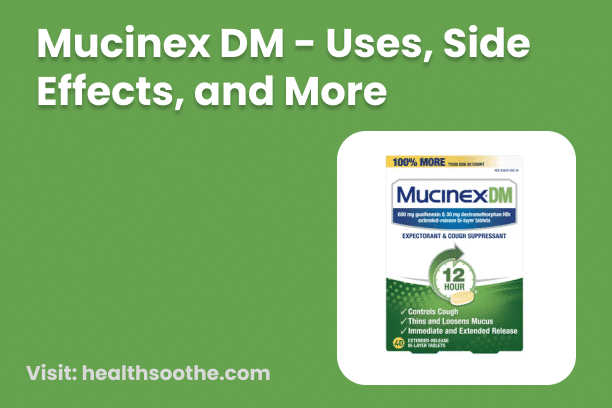- Instructions for Using Mucinex DM:
- Side effects:
- How long does Mucinex DM stay in your system?
- Precautions:
- Interactions:
This combination of medications (Mucinex DM) is employed to alleviate coughs stemming from the common cold, bronchitis, and other respiratory ailments. Guaifenesin falls within the category of expectorants, a group of medications.
Its mechanism involves diluting and loosening mucus in the air passages, effectively relieving congestion and facilitating easier breathing. On the other hand, dextromethorphan belongs to the class of cough suppressants. It functions by influencing the cough centre in the brain, lessening the urge to cough.
If you are using this medication without a prescription, it is vital to thoroughly review the package instructions before commencing its use to ascertain its suitability for you (also refer to the Precautions section). It's worth noting that cough and cold products are not proven to be safe or effective for children below 6 years of age.
This particular sustained-release product is not advisable for children under 12 years unless specifically instructed by a doctor. For a comprehensive understanding of safe usage, consult your doctor or pharmacist.
These products do not cure or shorten the duration of a common cold and may carry the risk of severe side effects. To mitigate such risks, adhere closely to the prescribed dosage guidelines. Avoid using this product to induce sleepiness in children.
Also, refrain from administering other cough and cold medications containing similar or identical ingredients (for more details, see the Drug Interactions section). If you seek alternative means of alleviating cough and cold symptoms, such as ensuring adequate fluid intake, employing a humidifier, or using saline nose drops/spray, consult a doctor or pharmacist.
Instructions for Using Mucinex DM:
Ingest this medication orally, with or without food, following your doctor's directions. Typically, it is taken every 12 hours, accompanied by a full glass of water. If you are self-administering, meticulously adhere to the directions on the product package. Should questions arise, consult your doctor or pharmacist. The prescribed dosage hinges on your age, medical condition, and treatment response.
Avoid consuming more than 2 doses within a 24-hour span. Do not amplify the dosage or increase the frequency beyond the stipulated guidelines. Refrain from crushing or chewing the medication, as doing so could release the entire drug content at once, heightening the risk of side effects.
If the tablets possess a score line and your doctor or pharmacist gives the green light, you may split them. Consume the whole or split tablet without crushing or chewing. Maintain ample fluid intake during the course of this medication. Fluids aid in breaking down mucus and relieving congestion.
Side effects:
You may experience dizziness, drowsiness, nausea, or vomiting. If any of these effects persist or worsen, promptly inform your doctor or pharmacist.
If your healthcare provider has prescribed this medication to you, it's important to recognize that they have weighed the benefits against the potential risks of side effects. Many individuals using this medication do not encounter severe side effects.
A severe allergic reaction to this drug is uncommon. However, if you notice any symptoms of a serious allergic reaction, such as a rash, itching, swelling (particularly of the face, tongue, or throat), severe dizziness, or difficulty breathing, seek immediate medical assistance.
This isn't an exhaustive list of potential side effects. If you observe other effects not mentioned above, reach out to your doctor or pharmacist.
How long does Mucinex DM stay in your system?
Mucinex DM contains two active ingredients: guaifenesin and dextromethorphan. The duration that these substances stay in your system can vary based on several factors, including your metabolism, liver function, kidney function, and dosage.
Guaifenesin has an elimination half-life of about 1 to 3 hours, meaning it's typically cleared from the body within a day.
Dextromethorphan has a half-life of around 2 to 4 hours, and it's usually metabolized and excreted within a day or so.
However, it's important to note that traces of these medications or their metabolites can still be detected in urine for a longer period after the effects have worn off. Urine tests might be able to detect these substances for a few days after ingestion.
The exact duration can be influenced by factors like the specific formulation of the medication, individual variations in metabolism, and the frequency of use. If you have concerns about how long Mucinex DM or its components may stay in your system, or if you're facing a situation that requires this information, it's recommended to consult your healthcare provider or a medical professional for personalized guidance.
Precautions:
Mucinex DM contains two active ingredients: guaifenesin and dextromethorphan. The duration that these substances stay in your system can vary based on several factors, including your metabolism, liver function, kidney function, and dosage.
Guaifenesin has an elimination half-life of about 1 to 3 hours, meaning it's typically cleared from the body within a day.
Dextromethorphan has a half-life of around 2 to 4 hours, and it's usually metabolized and excreted within a day or so.
However, it's important to note that traces of these medications or their metabolites can still be detected in urine for a longer period after the effects have worn off. Urine tests might be able to detect these substances for a few days after ingestion.
The exact duration can be influenced by factors like the specific formulation of the medication, individual variations in metabolism, and the frequency of use. If you have concerns about how long Mucinex DM or its components may stay in your system, or if you're facing a situation that requires this information, it's recommended to consult your healthcare provider or a medical professional for personalized guidance.
Read Also: Methocarbamol - Uses, Side Effects, and More
Interactions:
Interactions between drugs can impact how your medications function and potentially increase the risk of serious side effects. This document does not encompass every conceivable drug interaction.
It's advised to maintain a record of all the products you use, including both prescription and nonprescription drugs, as well as herbal products, and share this list with your doctor and pharmacist. Do not initiate, cease, or modify the dosage of any medications without obtaining your doctor's approval.
Using specific MAO inhibitors in conjunction with this medication could lead to a severe (and potentially fatal) drug interaction.
It's imperative to avoid the use of isocarboxazid, metaxalone, methylene blue, moclobemide, phenelzine, procarbazine, rasagiline, safinamide, selegiline, or tranylcypromine while undergoing treatment with this medication.
For most MAO inhibitors, a two-week gap before starting treatment with this medication is also recommended. Consult your doctor to ascertain the appropriate timing for starting or discontinuing this medication.
A product that might have an interaction with this drug is rolapitant.
Guaifenesin and dextromethorphan are present in both prescription and nonprescription medications. Thoroughly examine the labels of all your medications to ensure that you're not simultaneously using multiple products containing guaifenesin or dextromethorphan.
It's worth noting that guaifenesin may potentially interfere with specific laboratory tests (such as urine levels of certain acids), which could result in inaccurate test outcomes. Ensure that both laboratory personnel and your doctors are aware of your usage of this drug.


